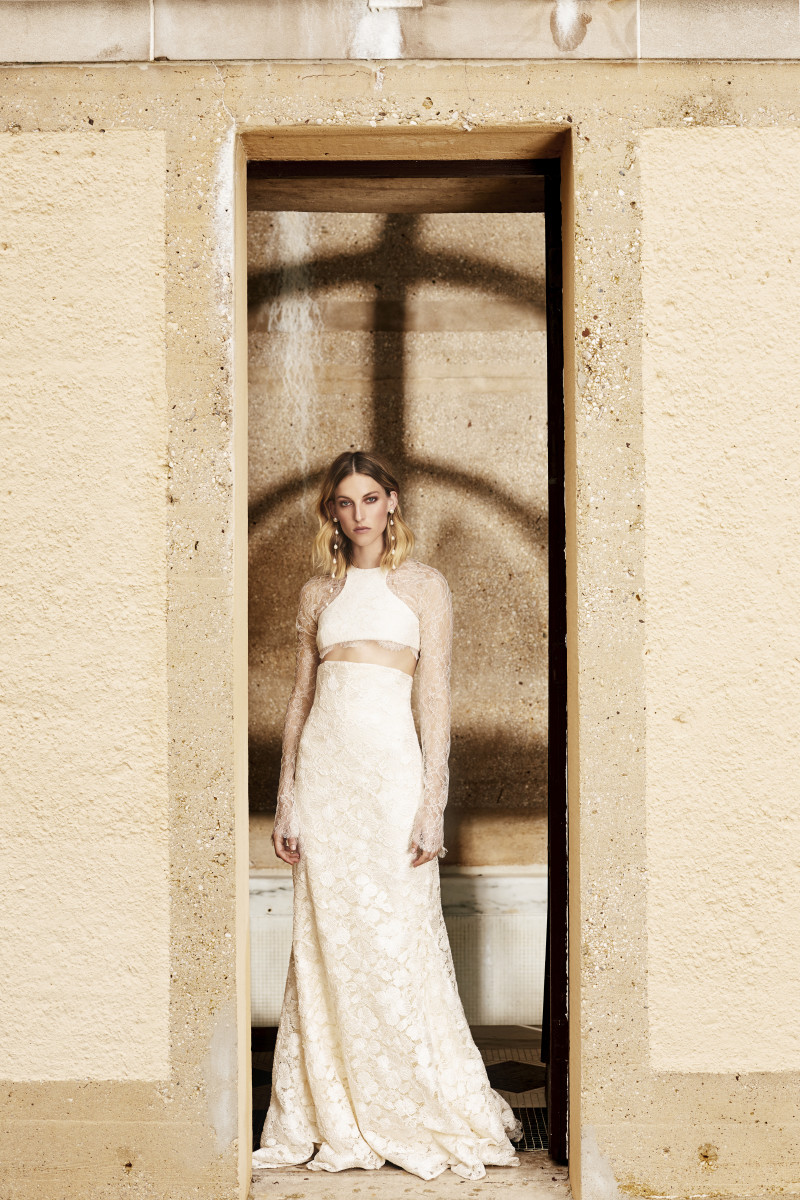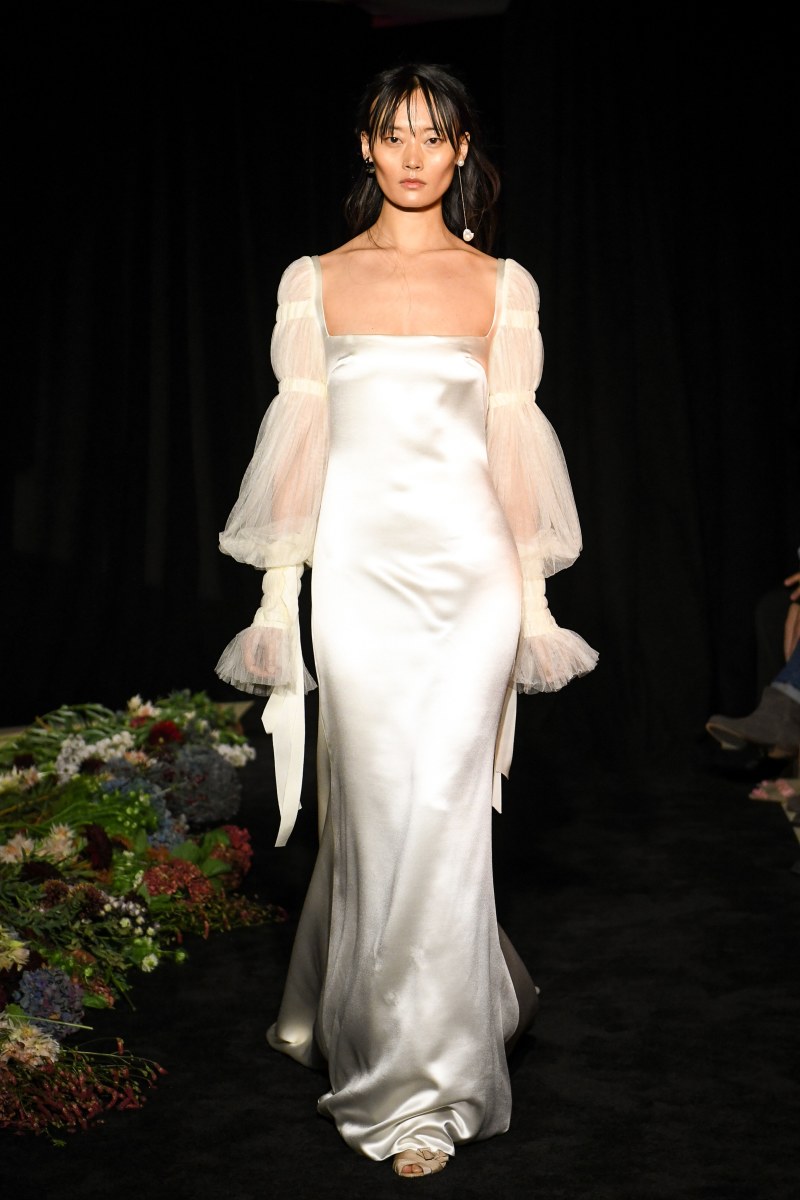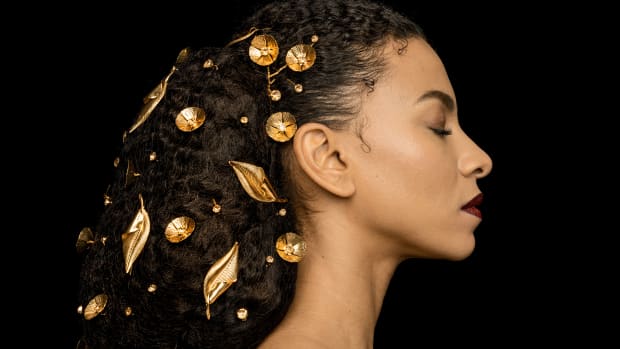The scene: a beautiful fall afternoon in the before-times, circa 2019, and after a day of ping-ponging all over Manhattan via Uber (and MTA and pedestrian routes, if you're me), editors
and buyers shuffle into seats and standing-room space at the Public Hotel. And wait. And wait, some more. The lights finally dim and — omg — Cardi B's favorite pianist, Chloe Flower, starts playing on a baby grand at the end of a winding runway. Stone-face models begin the style-forward procession, as murmurs ripple through the establishment crowd. It's a sheer lace trench coat and — gasp! — a see-through pantsuit, and then ... a cone-bra.
No, this wasn't New York Fashion Week. Rather, Danielle Frankel — the then-two-year-old bridal line founded by Danielle Hirsch — brought some fashion, with a capital "F," to "market," as the industry old guard refers to the bi-annual round of bridal shows and presentations, largely packed with floaty white dresses (and not celebrity sightings and boundary-pushing runway looks).
"I definitely gained this reputation as the rebel or whatever," says Hirsch, with a smile. "It's funny because I'm not doing anything particularly rebellious. We're just doing our own thing, which is also part of our success."
The Parsons alum hit the bridal scene straight out-of-the-box. Danielle Frankel's debut collection emphasized streamlined slips, columns and A-line silhouettes amid an abundance of flouncy ruffles, peak embellishments and statement capes for the Fall 2018 season. Sure, minimalism was making its way back (with Meghan Markle's trend-making wedding gown as the pinnacle), but Hirsch caused a stir — and laid the groundwork for what would become signatures — with distinctive, experimental details like exaggerated cuffs on a strapless lace jumpsuit, back cut-outs, sculptural bubble-skirting with variegated pleating and separates that revealed a peek of under-boob. And it wouldn't be the last time she'd break from the bridal establishment.
"I can't believe that people were responding to this because [the collection was] so simple," says Hirsch, recalling her surprise at the industry reaction. "But at the time, it was this palate cleanser for the industry. Maybe that's why we got the recognition that we did. Just because it was this fresh take, but it did have this fashion element as well."
Post-graduation stints at Marchesa and Vera Wang helped the young designer develop her own aesthetic and confidence to inject a fashion element into the traditional bridal category, which has been notoriously resistant to change — both in style elements, as well as, retail innovation.
"When you put yourself out there as a young designer, you're gonna sink if you don't have this other point of view," says Hirsch, who continues to challenge herself and her creative vision each season. In 2019, the CFDA/Vogue Fashion Fund recognized her wedding aisle-meets-catwalk crossover and named her a finalist — the first bridal designer to do so.
"For me, it was really important to just stick with what we were saying in our story, which was really adding this fashion element to a huge marketplace of of product," she says. "But I came from that Vera world, where she thought about things like, 'This is fashion.' I think that really actually educated me as to how to think that way, too."
Wang is, arguably, the first American bridal designer to become a go-to for celebrities. Fittingly, her former-mentee quickly cemented herself as a new-gen creative for betrothed A-listers: In an instantly viral 2019 moment, photogs papped Zoë Kravitz on the way to her rehearsal dinner in Paris wearing a custom fringed, baroque pearl-embellished mesh tunic dress layered over a bandeau top and biker shorts.
"It was a paparazzi photo, which always makes something a bit cooler because it wasn't a staged a red carpet, where you know there are people watching," says Hirsch. "It was a very natural thing." The statement also applies to dressing Kravitz for such a momentous occasion. (The actor's marriage may have ended in 2021, but the legacy of her bridal biker shorts remains evergreen.)
Recommended Articles
"You really want to dress the women, whom you really see as your ideal client," the designer, who was introduced to Kravitz through stylist Andrew Mukamal, says. "She was always somebody that I wanted to dress, regardless if she was engaged or not."
Danielle Frankel continued to be the cool celeb wedding designer of choice when future "Inventing Anna" star Julia Garner wore two looks from Fall 2020 to her own nuptials: a delicately-pleated tunic and trouser set with adorable ruffles at the hems, and a short-sleeve lace, back-cut-out mini dress. In 2020, Sara Foster wore the signature Ruby dress — featuring a square-neck silhouette with delicately pleated and gathered long puff-sleeves — to her wedding.
Famous or not, Hirsch's clients and their feedback are the ongoing source of inspiration for the designer. "Our evolution comes from really being with our clients and hearing from them: what they're looking for, what works for them, what they're responding to," she says.
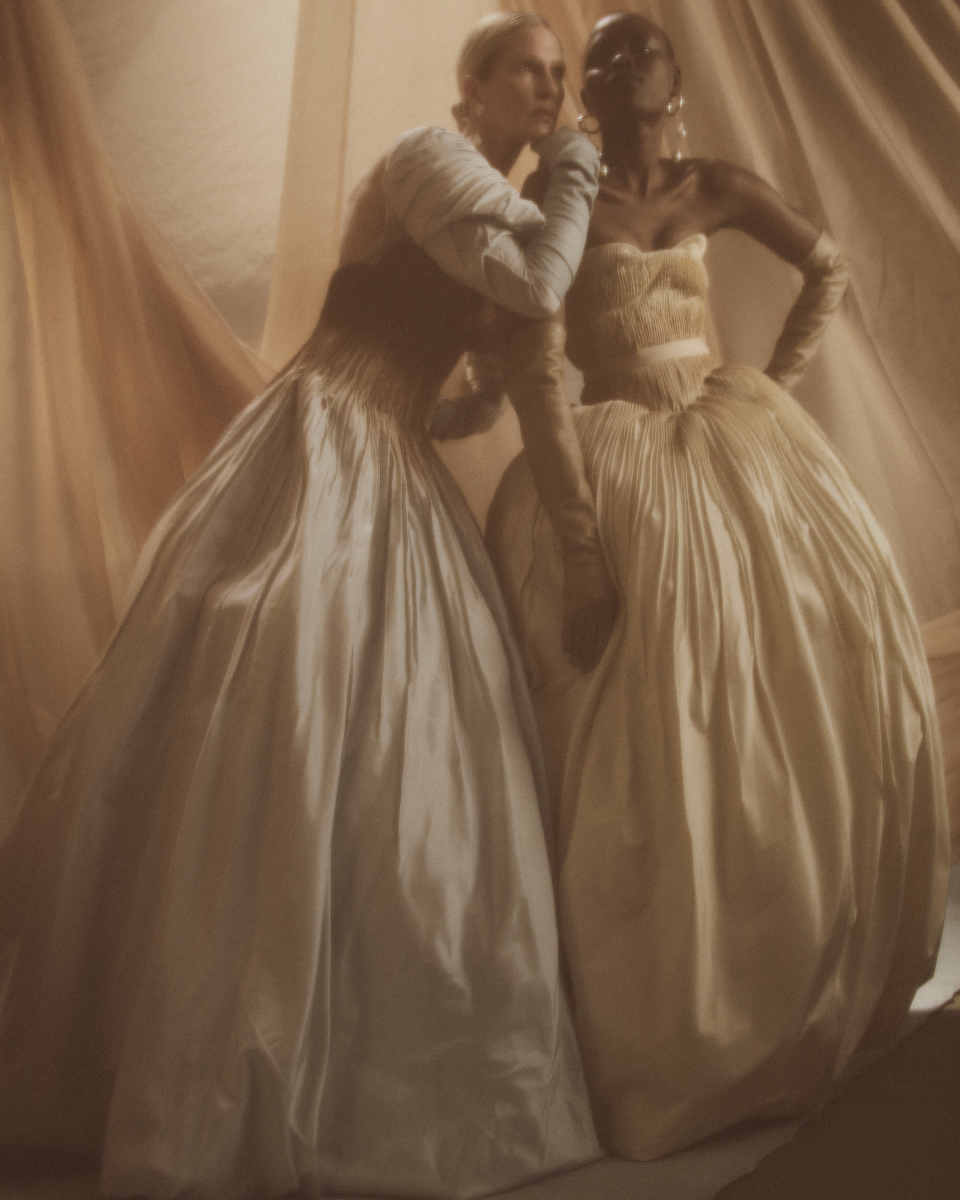
Looks from the Danielle Frankel Fall 2021 collection.
Photo: Stas Komarovski/Courtesy of Danielle Frankel
Currently, sizing runs from 0 to 24, but Hirsch has a curve collection launching "in the next coming months." Through customer feedback, select existing styles will be adjusted — "like with a bustier, the back closed up, longer sleeves, things like that," says Hirsch. "I'm really excited about that product just because I would love to service more women."
Hirsch considers her seventh collection, for Fall 2022, as "a sister" to the preceding one, which showcased an evolution of romantic draping, futuristic corsetry, intricate pleating, voluminous ball-gown skirting, architectural dropped-waist details and sculptural puffs of tulle and organza.
"Every collection is really a continuation from the one before — they all do look different, but they're definitely chapters within a larger story," says Hirsch. "I want somebody to be able to see one of our gowns and understand that it comes from us just from little hints."
After two years of pandemic lockdown, cancellation and rescheduling, big celebratory weddings — and therefore suitably elaborate ensembles — are back. "It's definitely larger, as far as volume and texture," says Hirsch of her latest. "Now we're getting these clients that are having these larger weddings, and they're looking to us for those pieces."

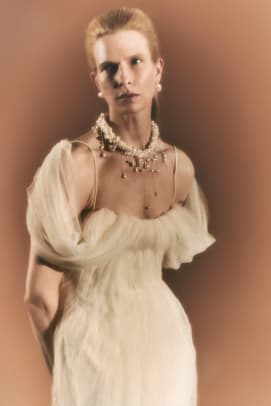
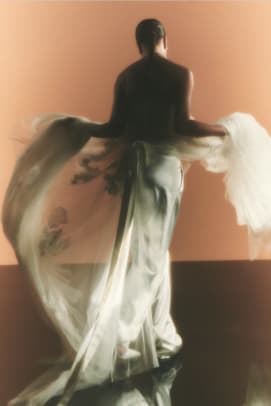
The designer enjoyed returning to the workroom to personally develop and hand-drape an oversized floral bralette, perfect for the second or third (or fourth) look. Hirsch is also excited about an exuberantly tiered, flower-embellished party dress, which accentuates her pleats signature with horsehair and lace appliqué: "I love that you look at the gown and you're like, 'OK, that's for dancing,'" she says.
Along with pushing the aesthetics of the traditional industry forward, Hirsch's retail model also breaks the mold. Manufacturing locally in New York City's Garment District, for one, allows flexibility with usually long-lead timelines, especially during the rushed and uncertain pandemic wedding planning.
"We stock a lot of [styles in the showroom], which doesn't sound special to some people," says Hirsch, explaining the nimbleness of immediate turnaround and supply for couples planning short-lead weddings. Reusing the same fabrics in all the collections also helps circumvent production issues other brands may experience.
"Two to three times a month, we meet with someone who's getting married the following week," says Hirsch. "The attitude towards a wedding and the planning process has completely shifted."
Never miss the latest fashion industry news. Sign up for the Fashionista daily newsletter.

